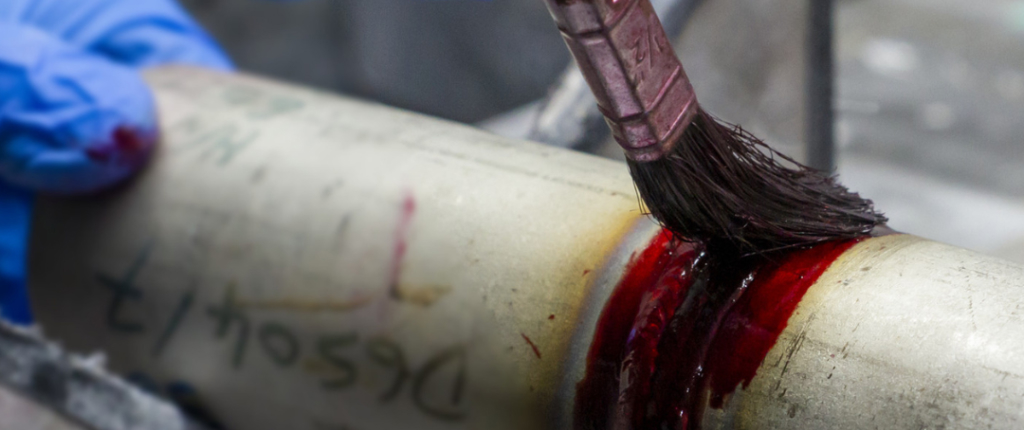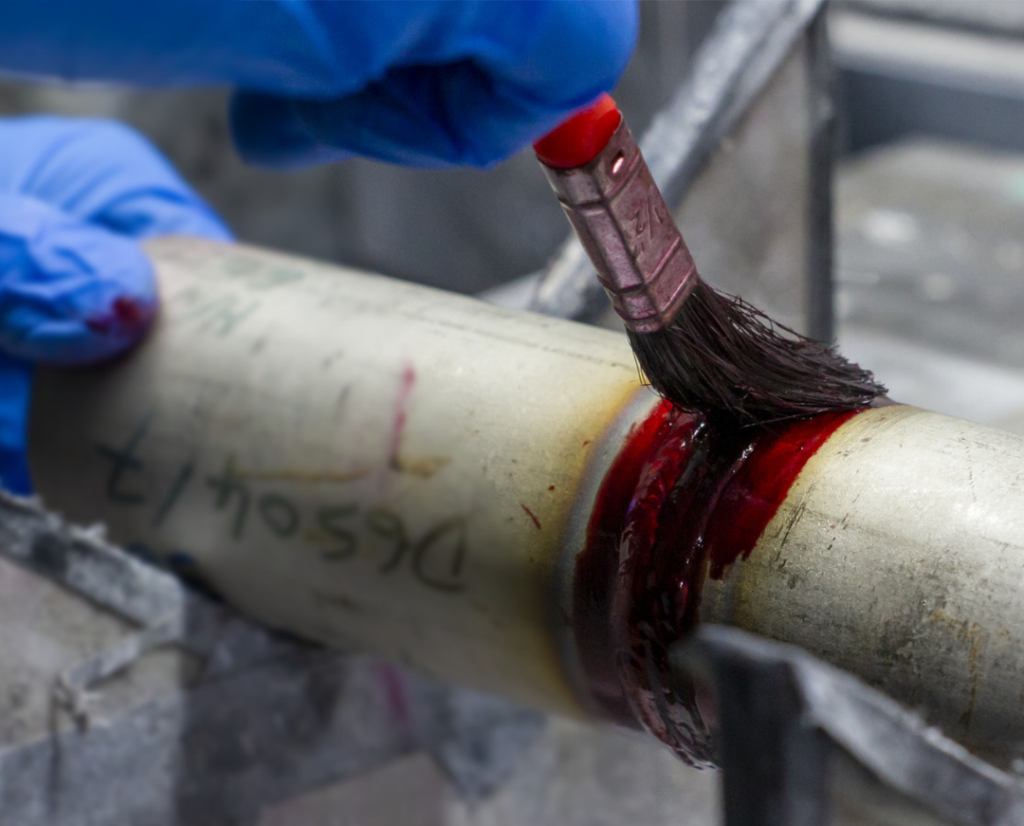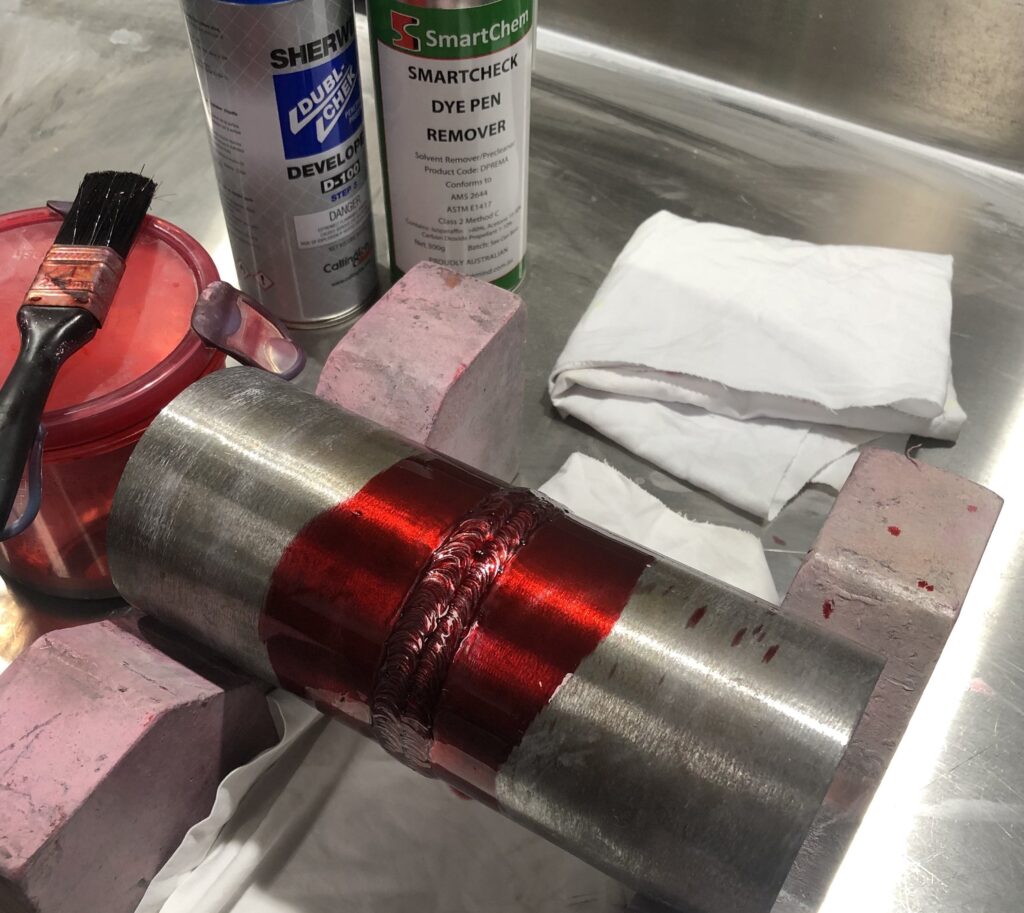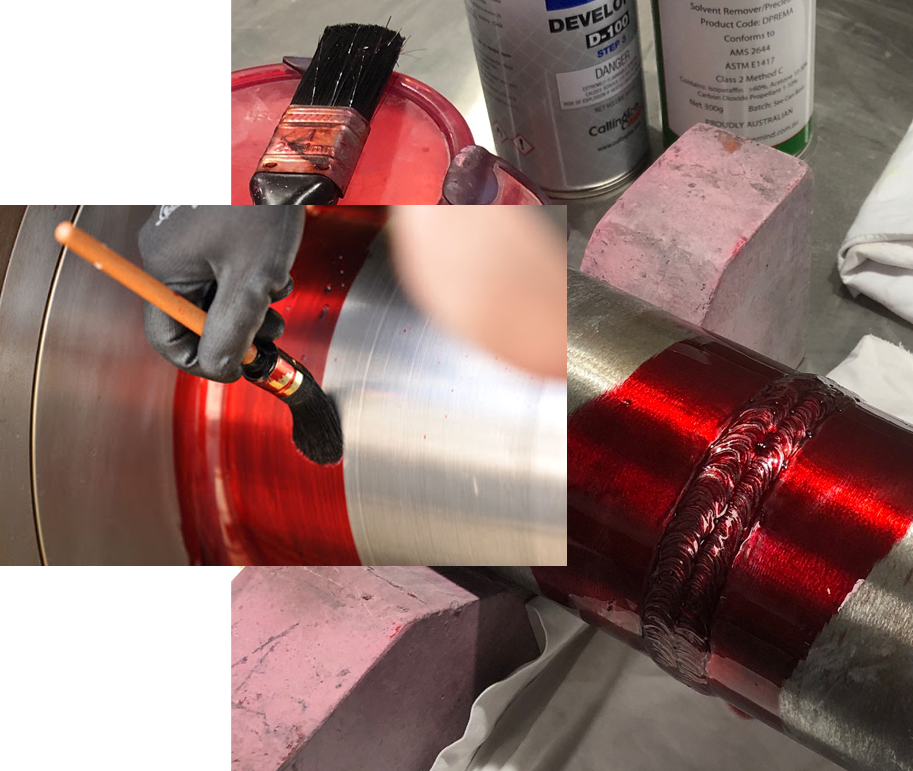Liquid Penetrant Testing
Dye Penetrant Testing (DPT): Detecting Surface Discontinuities in Solid, Non-Porous Materials

About
Liquid or dye penetrant testing is a non –destructive method for finding discontinuities that are open to the surface of solid and essentially non-porous materials. Indications of flaws can be found regardless of the size, configuration, internal structure, or chemical composition of work piece being tested and regardless of flaw orientation. Liquid penetrant can seep into (and be drawn into) various types of minute surface openings (reportedly, as fine as 4micro inch in width) by capillary action. Because of this, the process is well suited for the detection of all types of surface cracks, laps, porosity, shrinkage areas, lamination and similar discontinuities in casting, forgings, welds and other product forms. Dye penetrant inspection is used extensively for the testing of wrought and cast products of ferrous and non-ferrous metals, powder metallurgy parts, and ceramics and glass objects. In practice, the liquid penetrant inspection process is relatively simple. Equipment generally is simpler and less costly than that for most other NDT methods .When used on ferromagnetic steels, in some instances, the sensitivity of liquid penetrant test is better than that of magnetic particle testing
Limitations
● The major limitation of liquid penetrant testing is that, it can detect only imperfections that are open to the surface
● Another factor that may inhibit the effectiveness of liquid penetrant testing is the surface roughness of the object being tested
● Rough or porous surfaces are likely to produce false indication
● Liquid penetrant testing depends mainly on a liquid’s effectively wetting the surface of a solid work piece of specimen
● flowing over the migrating into cavities that are open to the surface
● Closely related to wetting ability is the phenomenon of capillary rise or depression
Testing Steps
The liquid penetrant testing
requires at least five steps:
Surface
preparation
Application of penetrant
Removed of Excess penetrant
Application of Developer
Observation and Reporting
Some of Our Clients!










Liquid Penetrant Testing or Dye Penetrant Inspection

Limitations
The major limitation of liquid penetrant testing is that, it can detect only imperfections that are open to the surface. Another factor that may inhibit the effectiveness of liquid penetrant testing is the surface roughness of the object being tested. Rough or porous surfaces are likely to produce false indication.
Liquid penetrant testing depends mainly on a liquid’s effectively wetting the surface of a solid work piece of specimen, flowing over the migrating into cavities that are open to the surface.Closely related to wetting ability is the phenomenon of capillary rise or depression.

The liquid penetrant testing requires at least five steps:
Application of penetrant.
Removed of Excess penetrant.
Application of Developer.
Observation and Reporting.
Liquid Penetrant Testing or Dye Penetrant Inspection
Liquid or dye penetrant testing is a non-destructive method used to detect surface discontinuities in solid, non-porous materials. It works by allowing a liquid to seep into minute surface openings through capillary action, making it effective for detecting cracks, porosity, and other defects. This method is widely used in testing ferrous and non-ferrous metals, powder metallurgy parts, ceramics, and glass objects.
- Detects flaws regardless of size, shape, or material composition.
- Ideal for finding surface cracks, laps, porosity, shrinkage, and laminations.
- Suitable for castings, forgings, welds, and various product forms.
- Simple, cost-effective process compared to other NDT methods.
- Often more sensitive than magnetic particle testing on ferromagnetic steels.

Limitations
The major limitation of liquid penetrant testing is that, it can detect only imperfections that are open to the surface. Another factor that may inhibit the effectiveness of liquid penetrant testing is the surface roughness of the object being tested. Rough or porous surfaces are likely to produce false indication.
Liquid penetrant testing depends mainly on a liquid’s effectively wetting the surface of a solid work piece of specimen, flowing over the migrating into cavities that are open to the surface.Closely related to wetting ability is the phenomenon of capillary rise or depression.

The liquid penetrant testing requires at least five steps:
Liquid penetrant testing is widely used across various industries, including aerospace, automotive, and manufacturing, due to its ability to detect even the smallest surface defects. This method is especially beneficial for inspecting components with complex shapes where visual inspection alone may not be sufficient.
01
Surface preparation.
The test surface is thoroughly cleaned to remove dirt, oil, and contaminants that could interfere with penetration.
02
Application of penetrant.
A liquid penetrant is applied to the surface and allowed to dwell, seeping into any surface discontinuities.
03
Removed of Excess penetrant.
The excess penetrant is carefully removed from the surface while ensuring it remains in defects.
04
Application of Developer.
A developer is applied to draw out trapped penetrant, making flaws visible for inspection.
05
Observation and Reporting.
The surface is examined under appropriate lighting, and any detected defects are documented for analysis.
Why Choose Us for Liquid Penetrant Testing?
- Ensures precise detection of surface defects.
- Suitable for a wide range of materials and industries.
- Simple, cost-effective, and highly accurate process.
- Detects flaws of all sizes, regardless of material composition.
- More sensitive than magnetic particle testing in some cases.
- Used extensively in aerospace, automotive, and manufacturing.
- Proven track record of accurate testing results.
- Experienced professionals dedicated to quality and safety.
1
High Precision Detection
Pinpointing even the smallest surface flaws with cutting-edge techniques.
2
Versatile Applications
Effective for metals, ceramics, glass, forgings, and welds.
3
Cost-Effective & Efficient
A reliable, affordable method ensuring top-notch quality control.
Liquid Penetrant Testing (LPT) is a non-destructive testing method used to detect surface discontinuities in solid, non-porous materials by allowing a liquid to seep into defects and reveal them under proper lighting.
LPT can detect surface cracks, laps, porosity, shrinkage, laminations, and other discontinuities in materials like metals, ceramics, and glass.
The LPT process includes five key steps:
- Surface Preparation – Cleaning the test material.
- Application of Penetrant – Applying a liquid penetrant to seep into defects.
- Removal of Excess Penetrant – Carefully wiping off excess penetrant.
- Application of Developer – Making flaws visible by drawing out trapped penetrant.
- Observation & Reporting – Inspecting and documenting results.
LPT can only detect surface-breaking defects and may produce false indications on rough or porous surfaces.
LPT is widely used in aerospace, automotive, manufacturing, and industries requiring high-precision surface defect detection.
LPT is often more sensitive for detecting fine surface defects in non-ferromagnetic materials, whereas Magnetic Particle Testing is limited to ferromagnetic materials.